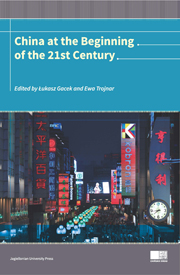Book contents
- Frontmatter
- Contents
- Acknowledgements
- Preface
- Chapter One Dagongmei in the Context of Rural-urban Migration Processes in Contemporary China
- Chapter Two The Linguistic Features of Chinese Internet Language
- Chapter Three Chinese Contemporary Art: Between Market and Freedom
- Chapter Four The Modernization of the People's Liberation Army since 1978
- Chapter Five The Reduced Role of the People's Liberation Army in the Political Succession to Deng Xiaoping and to Jiang Zemin: Chinese Style Civilian-Military Relations in the Making
- Chapter Six Chinese Involvement in Southeast Asia on the Example of Myanmar
- Chapter Seven China's Energy Policy towards Central Asia and Russia
- Chapter Eight Sino-Japanese Dispute over the Seabed Oil and Gas Resources in the East China Sea
- Chapter Nine China's Territorial Disputes in the South China Sea
- Chapter Ten The Way to Hong Kong Handover and its Implications
Chapter One - Dagongmei in the Context of Rural-urban Migration Processes in Contemporary China
Published online by Cambridge University Press: 05 September 2014
- Frontmatter
- Contents
- Acknowledgements
- Preface
- Chapter One Dagongmei in the Context of Rural-urban Migration Processes in Contemporary China
- Chapter Two The Linguistic Features of Chinese Internet Language
- Chapter Three Chinese Contemporary Art: Between Market and Freedom
- Chapter Four The Modernization of the People's Liberation Army since 1978
- Chapter Five The Reduced Role of the People's Liberation Army in the Political Succession to Deng Xiaoping and to Jiang Zemin: Chinese Style Civilian-Military Relations in the Making
- Chapter Six Chinese Involvement in Southeast Asia on the Example of Myanmar
- Chapter Seven China's Energy Policy towards Central Asia and Russia
- Chapter Eight Sino-Japanese Dispute over the Seabed Oil and Gas Resources in the East China Sea
- Chapter Nine China's Territorial Disputes in the South China Sea
- Chapter Ten The Way to Hong Kong Handover and its Implications
Summary
Since the late 1970s, the Chinese state has assumed a leading role in economic development. Deng Xiaoping took measures that boosted economic growth just when he lost faith in the Maoist model of central planning and collectivization, as well as realized that in terms of economic development China was considerably behind both new Asian Tigers (South Korea, Taiwan, Hong Kong, and Singapore) and Western capitalists. Rapid economic growth has legitimized the strategy of export-oriented industrialization, pursued through the open-door policy: export-processing, special economic zones, and incentives for foreign investors. Chinese scholars agreed to this kind strategy, as they perceived it as an application of the “grand international cycle” theory, which, in its fundamental nature, describes capital global search for new, cheap sites for investments.
In a short time, China's economic reforms have resulted in a phenomenon of millions of rural people seeking a better life and economic opportunity in the urban areas. These rural to urban migration flows made an impact on almost every social, economic, and political issue in the People's Republic of China. Migrants represent both agents of change at the places of origin and vital contributors to the economic growth in destination areas. Moreover, through migration peasants not only have become a part of the globalization process, but they also indirectly uncovered the rural and interior areas to its effects. Chinese migrants have been the subject of a considerable amount of academic studies of both Chinese and non-Chinese scholars.
- Type
- Chapter
- Information
- China at the Beginning of the 21st Century , pp. 13 - 24Publisher: Jagiellonian University PressPrint publication year: 2014



